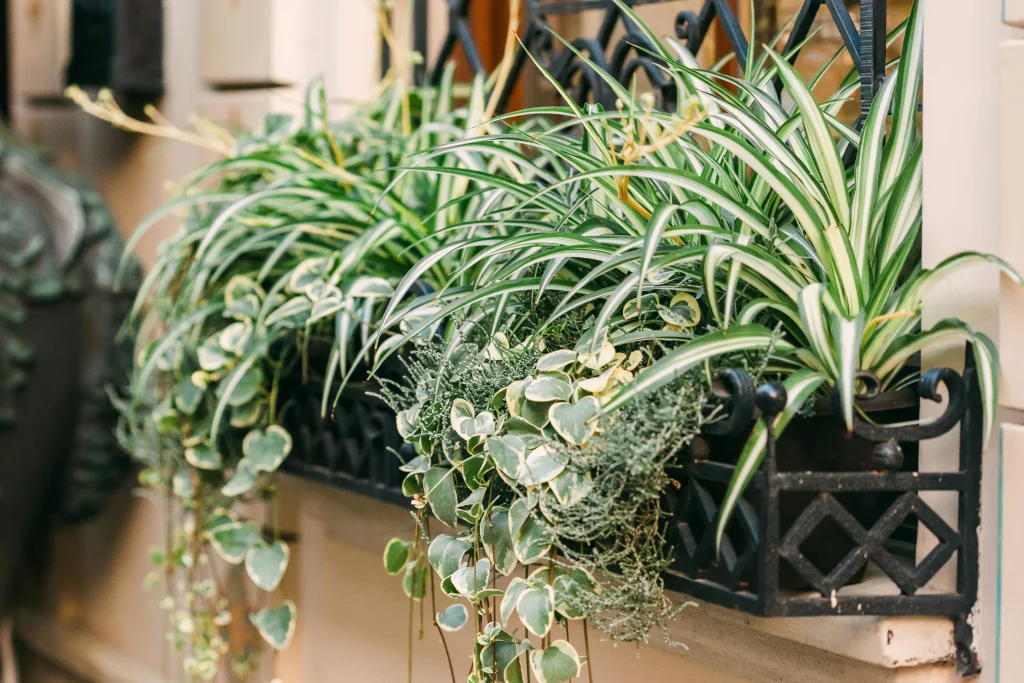Spider plants (Chlorophytum comosum) are cherished for their vibrant green and white leaves and easy-care nature, making them a favorite among houseplant enthusiasts. One of the key factors in keeping your spider plant thriving is providing the right lighting conditions. In this blog, we’ll explore the spider plant light requirements, how to optimize light for growth, and tips to avoid common lighting-related issues.
Ideal Light Conditions for Spider Plants
Spider plants are highly adaptable and can tolerate a range of lighting conditions, but they thrive best under specific circumstances. Here’s what you need to know about their ideal light requirements:
1. Bright, Indirect Light
- Best for Growth: Spider plants flourish in bright, indirect light, such as near a north- or east-facing window where sunlight is filtered through sheer curtains.
- Why It Works: This mimics their natural habitat under the canopy of larger plants, where they receive dappled sunlight. Bright, indirect light promotes lush foliage and healthy spiderette (baby plant) production.
- How to Achieve It: Place your spider plant a few feet away from a sunny window or use a sheer curtain to diffuse direct sunlight.
2. Moderate Light
- Tolerable Range: Spider plants can adapt to moderate light, such as in a room with ambient light or near a window with less direct sun exposure.
- Growth Impact: In moderate light, growth may slow, and variegation (the white stripes on leaves) may become less pronounced, but the plant will still survive.
- Ideal Spots: A corner of a well-lit living room or an office with fluorescent lighting can work well.
3. Low Light Tolerance
- Survivability: Spider plants can survive in low light conditions, such as rooms with minimal natural light or artificial lighting.
- Drawbacks: In low light, spider plants may become leggy, lose their vibrant color, or produce fewer spiderettes. Prolonged low light can weaken the plant over time.
- Tips for Low Light: If you only have low-light areas, consider supplementing with a grow light to mimic natural sunlight.
4. Avoid Direct Sunlight
- Risks of Direct Sun: Prolonged exposure to direct sunlight can scorch spider plant leaves, causing brown, crispy tips or faded foliage.
- Signs of Too Much Sun: Look for yellowing leaves, brown tips, or a bleached appearance.
- How to Prevent Damage: Move the plant away from south- or west-facing windows with intense sunlight or use a sheer curtain to filter the light.
How to Assess Your Home’s Lighting
To ensure your spider plant gets the right light, evaluate your space:
- East-Facing Windows: Ideal for bright, indirect light with gentle morning sun.
- North-Facing Windows: Provide consistent, soft light, perfect for spider plants.
- South- or West-Facing Windows: May require a sheer curtain to prevent direct sun exposure.
- Artificial Lighting: Fluorescent or LED grow lights (set to 12–16 hours daily) can supplement natural light in darker spaces. Aim for 1,000–2,000 lumens for optimal growth.
Pro Tip: Rotate your spider plant every few weeks to ensure all sides receive even light, promoting balanced growth.
Adjusting Light for Seasonal Changes
Light conditions in your home may vary with the seasons, so adjust care accordingly:
- Winter: Shorter days and lower light intensity may require moving your plant closer to a window or adding a grow light.
- Summer: Increased sunlight may necessitate moving the plant further from windows to avoid scorching.
- Cloudy Climates: In areas with frequent overcast skies, consider supplementing with artificial light to maintain healthy growth.
Common Lighting-Related Issues and Solutions
Even with their adaptability, spider plants can face issues if light conditions aren’t right. Here’s how to troubleshoot:
1. Brown Leaf Tips
- Cause: Often caused by too much direct sunlight, low humidity, or overwatering in low light.
- Solution: Move the plant to a spot with indirect light, trim brown tips with clean scissors, and ensure proper watering and humidity.
2. Faded or Yellowing Leaves
- Cause: Excessive direct sunlight or insufficient light can cause leaves to lose vibrancy or turn yellow.
- Solution: Adjust the plant’s position to provide bright, indirect light. If in low light, move closer to a window or add a grow light.
3. Leggy Growth
- Cause: Insufficient light causes the plant to stretch toward light sources, resulting in sparse, elongated growth.
- Solution: Relocate to a brighter spot or supplement with artificial light to encourage compact, healthy growth.
4. Lack of Spiderettes
- Cause: Spider plants produce fewer baby plants in low light or if stressed by improper care.
- Solution: Ensure bright, indirect light and maintain consistent watering and fertilization to encourage spiderette production.
Additional Care Tips to Complement Light Requirements
To maximize your spider plant’s health, pair proper lighting with these care practices:
- Watering: Keep soil evenly moist but not soggy. Water when the top inch of soil feels dry, typically once a week.
- Soil: Use well-draining potting soil to prevent root rot.
- Humidity: Spider plants prefer moderate humidity (40–60%). Mist occasionally in dry environments.
- Fertilization: Feed with a balanced, water-soluble fertilizer (e.g., 10-10-10) every 4–6 weeks during spring and summer.
- Pruning: Trim yellow or damaged leaves to maintain appearance and encourage new growth.
Benefits of Proper Lighting for Spider Plants
Meeting spider plant light requirements offers several benefits:
- Enhanced Growth: Bright, indirect light promotes lush, vibrant foliage and frequent spiderette production.
- Air Purification: Healthy spider plants are more effective at removing indoor toxins like formaldehyde and benzene, as noted in NASA’s Clean Air Study.
- Aesthetic Appeal: Proper lighting keeps variegation bold and leaves healthy, enhancing your home’s decor.
- Stress Reduction: A thriving spider plant adds a calming, natural element to your space, boosting well-being.

Conclusion
Spider plants are forgiving and adaptable, but providing the right light is key to unlocking their full potential. By placing them in bright, indirect light, avoiding direct sunlight, and adjusting for seasonal changes, you can ensure your spider plant thrives with lush foliage and plenty of spiderettes. Whether you’re a beginner or a seasoned plant parent, understanding spider plant light requirements will help you keep this low-maintenance houseplant healthy and beautiful.



